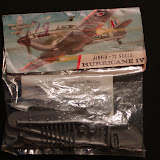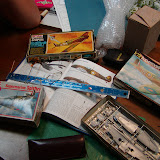
In the early 1970's, there were some indications that interest plastic model aircraft was waining on the western side of the Atlantic. This was probably for a variety of reasons, though the biggest was that many of those youngsters that had started building these kits in the 50's and 60's had now aged, and many of the gimmicks that were used to sell the kits back then were failing. In the UK, of course, it was a slightly different story, with both Airfix and Frog booming along.
MPC was known stateside mainly for model cars in 1/24 scale. In the mid-1960's, they began to import, and later produce, Airfix kits. They used some unusual methods to get people to buy their kits, such as including chromed parts and wild custom decals for a while.
Obviously, that didn't work.
So, they took what can only be described as a more English approach. In the UK, a series of booklets had been published for a while known simply as "Profile Publications". Each of these booklets contained information on a single aircraft or variant, complete with, you guessed it, full colour profiles. When I was young, I would stand, mesmerised, at the book rack in Art's Hobby Shop, staring at the vast number of them he carried.
Anyway, MPC decided to use the Profile booklets as a starting point for a new line of Airfix kits. Each kit would come with decals for three different aircraft, allowing the modeller to choose which aircraft he wanted. In a way, it was akin to the customising that American car modellers had enjoyed for a few years at that time. Some kits even came with parts to allow different variants to be built, though this could be traced back to the dies that Airfix had tooled originally.
Suffice to say, the new line of MPC kits were a hit.
They weren't perfect, however.
Take the Wildcat, for instance.

When this model was being sold by Airfix, it contained markings for two aircraft; one Fleet Air Arm, the other US Navy. The plane itself represents an FM-2, the very last Wildcat variant built (and made by General Motors, not Grumman). This plane was a bit different than the original F4F-3 or -4. That didn't stop MPC from including decals not only for an F4F-3, but for an even rarer G-36, Grumman's early export model that the British ended up with.
This wasn't the only time they dropped the ball where that was concerned.
Then, there were the decals. My biggest complaint for years was how light the blues tended to be. Other decals, namely from later kits, were printed on material that was very thick and refused to adhere to anything but a perfectly smooth, flat and very glossy surface.
Still, the Profile Series from MPC introduced many people to the hobby. They were usually sold very inexpensively at outlets ranging from convenience stores to department stores. The line finally faded from public view around the mid-1970's, with the author seeing the last few kits vanish from our local Woolco's around 1978.
For the collector, the boxes are pretty nice, with information lifted directly from the Profile booklets. Sometimes, the colour information on the instruction sheets left something to be desired. The models themselves were almost always moulded in white, though I have heard reports of other shades such as silver and light blue being used. Beyond that, they were still Airfix kits, though under cover.
MPC would once again become involved with Airfix in the early 1980's, when they produced a number of kits as Airfix was going through some difficulties. These were a far cry from the old Profile series, basically being American reboxing's only. This would be MPC's last foray into military models. By the end of the century, MPC itself would be gone, to emerge later as simply a brand name only.



